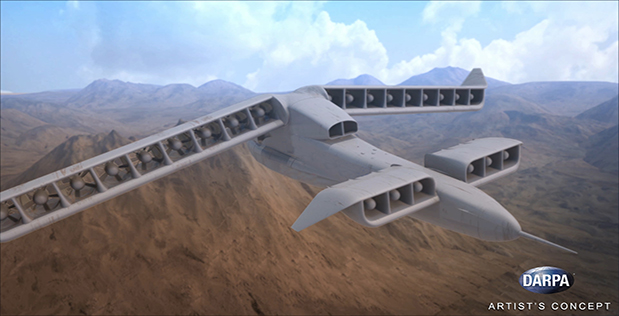When it comes to vertical takeoff and landing (VTOL) many aircraft designers have tried to improve capabilities without sacrificing range and efficiency. DARPA has launched a new program to solve these issues and create “an unorthodox unmanned aircraft that would push the limits of technology to combine plane-like speed and helicopter-like agility into one breakthrough vehicle.”

The VTOL Experimental Plane (VTOL X-Plane) program will incorporate two sets of aircraft technologies: fixed-wing and rotary-wing, and will develop new systems for improvements in vertical and cruising flight capabilities.
The agency has now awarded the Phase 2 contract for VTOL X-Plane to Aurora Flight Sciences, taking another step forward in the development of such an aircraft.
“Just when we thought it had all been done before, the Aurora team found room for invention—truly new elements of engineering and technology that show enormous promise for demonstration on actual flight vehicles,” said Ashish Bagai, DARPA program manager. “This is an extremely novel approach,” Bagai said of the selected design. “It will be very challenging to demonstrate, but it has the potential to move the technology needle the farthest and provide some of the greatest spinoff opportunities for other vertical flight and aviation products.”
So, what will a VTOL X-Plane be able to do? According to DARPA, the aircraft would be able to achieve a flight speed of 300 kt to 400 kt, increase aircraft hover efficiency from 60% to at least 75%, and carry a useful load of at least 40% of the vehicle’s projected gross weight of 10,000 to 12,000 pounds.
The vision is an unmanned aircraft with two large rear wings and two smaller front canards—short winglets mounted near the nose of the aircraft, equipped with a turboshaft engine mounted in the fuselage that would provide 3 megawatts (4,000 horsepower) of electrical power (that’s the equivalent of an average commercial wind turbine). The engine would propel 24 ducted fans and the wings and the canards would rotate to direct fan thrust as needed: rearward for forward flight, downward for hovering and at angles during transition between the two.
The plane would fly fast and over long distances, as well as hover and accomplish missions without needing prepared landing areas. The aircraft would initially be demonstrated as an unmanned craft, but the technologies would also allow for it to be manned.
DARPA hopes to get flight tests running by 2018.
“This VTOL X-plane won’t be in volume production in the next few years but is important for the future capabilities it could enable,” said Bagai. “Imagine electric aircraft that are more quiet, fuel-efficient and adaptable and are capable of runway-independent operations. We want to open up whole new design and mission spaces freed from prior constraints, and enable new VTOL aircraft systems and subsystems.”
Story via DARPA.

Comments are closed, but trackbacks and pingbacks are open.